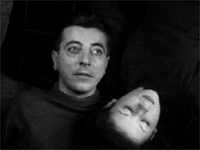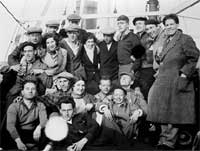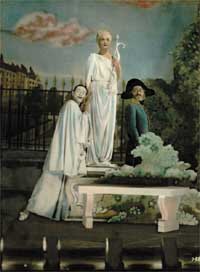Jacques Prévert: poet of our times
by Alison Hird
Article published on the 2008-11-09 Latest update 2008-11-10 16:49 TU
Culture: Jacques Prévert
Generations of French schoolchildren have grown up learning poems like Prevert’s Déjeuner du matin (Morning Breakfast) by heart:
“He put the coffee/ Into the cup/ He put the milk/ Into the cup of coffee/ He put the sugar/ Into the cafe au lait/ With the little spoon/ He stirred/ He drank the coffee/ And he replaced the cup/ Without speaking to me…”
Prévert is a national institution. Around 400 French schools are named after him, more than any other French figure.
As with all national treasures, however, he has his detractors.
French writer Michel Houllebecq, never one to mince his words, famously attacked Prévert in his book Interventions, calling him "flat, superficial and false".
But the Prévert, Paris la belle exhibition currently running at Paris' City Hall does an admirable job of showing Prévert as a multi-facetted artist whose message, more than 30 years after his death, is far from superficial.
His granddaughter, Eugenie Bachelot-Prévert, co-curator of the exhibition, wanted it to reflect the "lucidity and liberty" that so defined her grandfather.
"We wanted to show how coherent his work is, to leave the clichés behind. Because Jacques Prévert is both well-known and misunderstood," she says.She quotes an alternate version of the French national anthem, the Marseillaise, that her grandfather wrote, in which he replaced "May a very pure blood water our fields" by "May impure blood water your millions".
"At a time when booing the Marseillaise in public is forbidden, or with the sub-prime crisis, [his work] is like a breath of fresh air," says Bachelot-Prévert. "It’s very relevant.""Prévert couldn’t care less about being politically correct," co-curator N.T. Binh points out. "He did very famous poems about immigration… about the power of money. Until the end of his life he was fighting for his ideas through his works."
Ideas that were always on the left, first forged when as a child he accompanied his father, a charity worker, on visits around poor working-class areas of Paris.
Prévert with first wife Simone, André Breton and brother Pierre, circa 1925 during the 'Rue du Chateau' period In the 1920s he was a key figure in the Rue du Chateau group, a collective of Surrealist painters and poets including Yves Tanguy, André Breton, Raymond Queneau, Pablo Picasso and Alberto Giacometti. 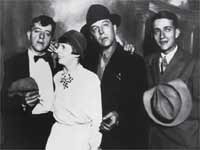
(Photo: (c) DR/ Collection Catherine Prévert)
In the early 30s Jacques Prévert wrote sketches and plays for the October Group of radical cabaret performers, founded at the time of the Soviet Revolution in 1917. Prévert’s La Bataille de Fontenoy satirised politicians of the time and was presented in 1933 at the International Workers Theatre Olympiad in Moscow where it won first prize.
Prévert moved from theatre to cinema in the late 30s, writing screenplays and dialogue for a series of chefs-d’oeuvre up to the end of the war, including Drôle de drame (Bizarre, Bizarre, 1937), Le quai des brumes (Port of Shadows, 1938), Le jour se lève (Daybreak, 1939) and Les visiteurs du soir (The Night Visitors, 1942).
Visitors to the exhibition can watch extracts from several such films. Prévert had a particularly fruitful collaboration with the director Marcel Carné with whom he developed what is known as poetic realism. Prévert wrote the screenplay and dialogue to Carné’s award-winning Les enfants du Paradis (The Children of Paradise, 1945). Filmed during the occupation in Paris, it was later voted best French film ever by a jury of 500 cinema professionals.A lesser-known side to Prévert is his talent for collage. While he did them for his own pleasure, these playful, colourful and deeply inventive artworks are now collector’s items.
In Amants, Prévert reworks a Brassaï photo, replacing the lovers’ heads with vermillion beating hearts. Another sees him uprooting the Sacré Coeur cathedral from Montmartre and sticking it firmly onto the Ile de la Cité near Notre Dame.
N.T. Binh says his collages are the embodiment of his subversive tendencies: an ongoing desire to revisit and rework the world around him in unexpected ways.
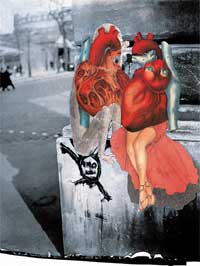
Amants, collage on a photo by Brassaï
(Photo: (c) Fatras, Jacques Prévert estate / private collection Jacques Prévert)
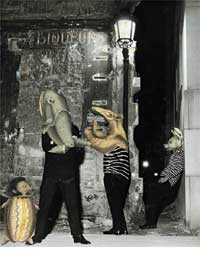
Les garçons de la rue, collage on a photo by Robert Doisneau
(Photo: (c) Fatras, Jacques Prévert Succession/ private collection Jacques Prévert)
Outside France, Prévert is most famous for Autumn Leaves, a song that has been recorded by numerous artists, from Edith Piaf, to Joan Baez, to Serge Gainsbourg.
The music was composed by Joseph Kosma, one of several Jewish friends Prévert hid from the Nazis during the Second world war….Culture
Cracking skulls!
2010-02-15 12:35 TU
France's gothic avant-garde
2010-02-13 15:16 TU
Winter sounds warm up French jazz fans
A tribute to trumpeter Don Cherry at a Free Jazz showcase festival outside of Paris.
2010-01-31 11:55 TU
Trance on a trapeze
2010-01-30 12:41 TU
Retro Mobile - classic car exhibition
260,500 euros for rusty old car found at bottom of lake
A rusty old Bugatti, which spent years at the bottom of a Swiss lake, sold for 260,500 euros at the Retro Mobile classic car exhibition on Saturday. Other more lovingly-restored pristine examples are exciting enthusiasts from across the world in a special anniversary event at Porte de Versailles in Paris.
2010-01-23 20:21 TU
France's changing face looks east
2010-01-22 16:17 TU
Putting art on film
2010-01-20 13:09 TU
What sex is a coffee bean, where does the aubergine come from?
2010-01-08 16:08 TU
Cocteau Twin flying solo
2010-01-06 16:43 TU
A taste of Nordic filmmaking in Paris
Ciné Nordica 2009 at Paris’s Panthéon cinema showcases filmmaking from Scandinavia. So what makes Nordic film different from the rest?
2009-12-22 17:15 TU




